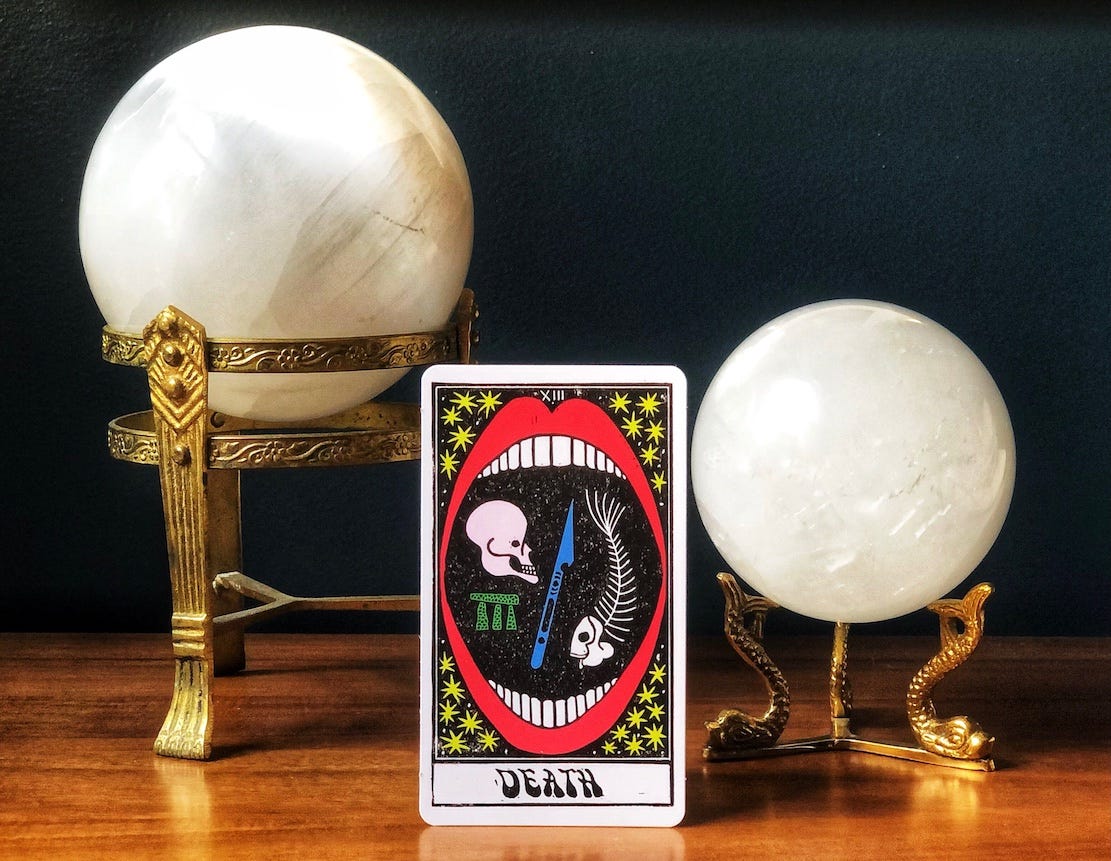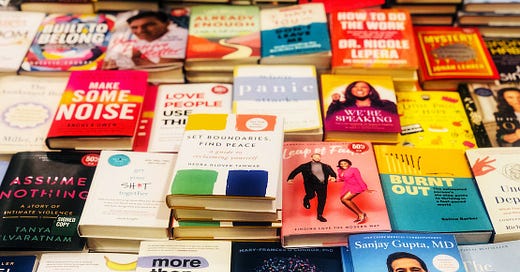Like many people, my life until this point has been an ongoing exercise in trial and error. There were highs and lows, pleasant surprises, spectacular crashes-and-burns.
Along the way, I developed a sense for recognizing ordinary, everyday nightmares. Perhaps you’ve met them, too — the nightmare date, the nightmare boss, the nightmare client. I grew skilled at dissecting and unpacking, at advising friends in similar situations. But it would take a great deal longer to learn how to actually manage them. How to say no. How to walk away. How to ask for help.
It’s incredible, the energy I’ve devoted to red flags when one white flag was all I needed.
Over the course of the last year, we watched a number of powerful women advocate for themselves — and their mental health — by taking a step back.
In May 2021, tennis player Naomi Osaka withdrew from the French Open, disclosing that she struggles with anxiety and depression.
In July 2021, gymnast Simone Biles withdrew from the final individual all-around competition at the Tokyo Olympic Games, to focus on her mental health.
Last week, singer/songwriter Adele shared a video in which she tearfully explained she was postponing her Las Vegas residency due to delivery delays and crew members testing positive for COVID.
As with most public declarations made by women, they were met with a mix of celebration and condemnation. In case there is any doubt, count me firmly on team applaud. I’m glad that, as a society, we seem to be normalizing the act of prioritizing mental health. At least in theory.
In the last year, article after article talked about The Great Resignation, wherein record numbers of Americans voluntary resigned from their jobs. As I was writing this, an email popped up advertising the NYTimes Guide to Quitting Your Job, which breaks down the logistics better than I ever could.
But that’s just one piece of the story. Quitting is a privilege. Not everyone can afford to walk away; most are not in a position to leap and hope the net will appear.
What I’m after is a bit more universal. More accessible, too. In the spirit of self-advocacy, what does it mean to take care of oneself? What does it look like? And how might it be different now than it was before?
Too often we are sold an image of “wellness” that involves drinking green juice while remaining on the relentless treadmill of modern life. We’re encouraged to consult books and courses and podcasts and seminars, offered consumption as a first step toward enlightenment. I’m all for an illuminating read — my shelves are cluttered with Oprah’s Book Club picks and manuals from various disciplines. But no matter what anyone claims, there is no universal path, no catch-all approach or surefire strategy.
The more methods I am advertised, the more skeptical I become. Perhaps the world, with its demands and systems and judgments, is what needs adjusting. Perhaps we — just as we are — are already more than enough.
True wellness, whether spiritual, physical, or emotional, seems rooted in self-inquiry. How can you respect your own boundaries if you don’t know where they are? Or live with integrity if you don’t know what you believe?
My own definitions keep shifting with time. I used to think it was all about “balance.” Balance, I’ve discovered, is a two-faced word, and an equally two-faced concept. On the one hand, it describes a beautiful equilibrium. On the other, it’s what’s needed when you’re walking a tightrope — something you desperately try to maintain so you do not fall.
My version of balance often looked more like the second one. No wonder it didn’t last.
One silver lining of these strange times has been a necessary shift in perspective. I used to be pretty lone wolf in my approach to, well, everything. But I’ve since discovered that reinforcements are key — loved ones, friends, books, therapists, congregations, medication — whatever it looks like for you. It’s ironic that sometimes the best way to help yourself is to admit you can’t do it alone.
The “Self-Transformation” section at my local bookstore has undergone a bit of a makeover in recent years. Along with the usual offerings on habits and positive affirmations, the shelves are now crowded with volumes about spells and magic, witchcraft and ritual, the positions of stars and the phases of the moon. At the risk of sounding like Zoolander, magic is so hot right now.
But when it comes to everyday magic, there are only three spells I cast with regularity:
Yes.
No.
Help.
Three of the most powerful syllables one can utter. They can open up worlds, stop issues in their tracks, lift the weight off your shoulders. I have learned to use them with care. Each its own act of courage. Each its own act of strength.
Card of the Week
Here is this week’s card for the collective, as well as some thoughts to carry into the days ahead. As most modern readers will tell you, the tarot is not about fortunetelling, nor is it about neat, definitive answers. The cards are simply one path to reflection, a way of better knowing ourselves and others through universal themes. If this reading resonates with you, great! And if not, no worries. Take whatever may be helpful and leave the rest.

There are two cards in a tarot deck that always get a reaction — The Devil and Death. “The death card does not mean death!” trills every tarot reader, before they lose their audience. For anyone thinking, “Wow, I’m so glad I signed up for this uplifting publication,” do not dismay. This card is actually a good thing, and I’m not just saying that.
In tarot, Death is not about death (in a literal or predictive sense). Rather, it’s a card about cycles, as much about rebirth and new beginnings as it is about endings. Embrace the inevitability of movement, it tells us, and there is growth to be found.
If you’ve been wanting to shake up some aspect of your life, be it a job, relationship, living situation, habit, chili recipe, what have you…this is a welcome sign. Personally, I’ve found this card often hints at a change in thinking, particularly how the way we confront things can drastically alter how we experience them.
In the traditional Rider-Waite-Smith deck, the image of Death is this terribly frightening skeleton-knight on horseback. No one in their right mind would be thrilled to see this riding toward them in a parking lot. True to form, the other characters on the card don’t seem too jazzed about it, either — they’re in various stages of passing out, while a religious figure stands, pleading and bargaining.
But then there is a child.
The card’s lone youth does not appear upset by this ominous presence. On the contrary, the child seems curious, engaged, even amused to be witnessing this spectacle. There isn’t a hint of resistance to be found. It reminds me of a favorite quote often shared by Buddhist teachers, “Pain is inevitable. Suffering is optional.”
Over the course of our lives, we learn to carry our unique emotional baggage. We might unpack and repack, adding or subtracting fears and biases as we tailor our expectations to reflect our lived experiences.
By the time we reach adulthood, we are likely acquainted with danger, disappointment, and heartache, and do our best to avoid it. From an evolutionary standpoint, fear can be protective, and I certainly don’t encourage anyone to put themselves in harm’s way. But this card offers a reminder that many of our anxieties live exclusively in our minds. And if we can approach them with a touch more openness, we might be surprised by our own strength.
“Fear is a natural reaction to moving closer to the truth,” wrote Pema Chödrön. “When we are willing to stay even a moment with uncomfortable energy, we gradually learn not to fear it.”
Every time we face something that scares us (or that feels unpleasant… or that we don’t know how to do…) we experience a tiny rebirth. We say goodbye to our old, uninitiated selves and hello to a new incarnation, the us who knows more.
This deck’s interpretation, with its vibrant, gaping mouth, carries an additional message about power and connection.
It is said that every time you speak, the words die as soon as they leave your lips. But something else happens, too — they take on a new life of their own, in the minds and hearts of the people who internalize them. In a way, we all have the power of the scary knight on horseback. We choose what lives — the thoughts in our minds, and the words we offer others.
That brings us to the most ironic thing about the Death card. If you dig deep enough, it’s actually about kindness.
In its universality, this card comes with a poignant reminder: we all fear the same things. Despite our differences, on the inside, it’s mostly common ground. You are not alone in your fears, doubts, anxieties, humanity. Neither are you alone in your hopes.
As we move through the world, every word, every action, is its own act of rebirth. So to whomever you encounter — including yourself — be truthful. Be mindful. Be kind.
Thank you so much for reading! If you enjoyed this letter and would like to receive future installments in your inbox every Sunday, please consider becoming a subscriber.









I look forward to reading your newsletter every Sunday! It’s a great way to start a new week (and reflect on the previous one) with a fresh perspective.
"It’s incredible, the energy I’ve devoted to red flags when one white flag was all I needed." Damn, Donofrio. That's magic.